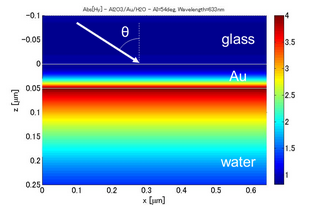Research
Fluct-Molecular Sensing
Molecules are challenging to reproduce the behavior and function of nature even when static states are understood and imitated. This is because molecules and their aggregates are always 'fluctuating'. We are focusing on developing passive and active sensor technologies to measure and utilize the spatiotemporal fluctuations of biological and chemical molecules. This research can be divided into basic and cross-disciplinary research for novel molecular measurement and utilization technologies; applied research with clearly defined application targets, such as healthcare and the environment.

1. Simulation for investigating phenomena and designing sensor structures

We use simulation and numerical calculation to investigate optical phenomena that are used to measure molecules and to design sensor structures.

As an example, this figure shows the results from a computer simulation that helps explain a scientific process known as Surface Plasmon Resonance (SPR). This process happens when light shines on a thin gold film. The light causes the electrons in the gold to move together in waves. We call these waves Surface Plasmon Polaritons (SPPs). In the simulation, you can see how these waves move across the surface of the gold and into the surrounding water. SPR is an interesting scientific concept because it happens when light reflects off a thin metal surface at a certain angle. This can be used to watch how molecules interact with each other in real time without needing to mark them with any special labels.
2. Novel passive and active biosensing principles

This research aims to prove new passive and active sensing concepts that allows you to measure and use the spatiotemporal fluctuation of gas-phase and liquid-phase molecules. Thes sensing techniques are mainly optical, such as surface plasmons, which are powerful and suitable for sensing molecules near a sensor surface. Along with the transducers, we design the surface architecture of biorecognition elements to maximize their capabilities to capture target molecules stably and selectively.
More in details: under construction
3. Biosensors for medical and healthcare

This research aims to develop biosensors that can help extend healthy life expectancy and smaller the gap from the average life expectancy. Health status is affected by internal and external factors, such as the food you eat, pills you take or allergens you are exposed to, etc. We believe that monitoring these factors will bring spatiotemporal information telling how to manage the risks for health in life.
Bioaerosol (airborne allergens, viruses, etc.) monitoring for preventing enviromental allergies & infectious diseases

Bioaerosols are potentially harmful airborne biological substances. Since the bioaerosols are too small to be aware of, we are exposed to them without notice, which may lead to various diseases, such as allergies and infectious diseases. We have been developing immunosensors to capture and continuously measure bioaerosols. In general, immunosensors are not suitable for repeated measurement because surface regeneration is necessary, which may potentially damage antibodies or anchor molecules on a sensor surface. In the past, we have developed surface acoustic wave (SAW) immunosensors for mite allergens (Der f1 and Der f2). By using the SAW device and robust anchor proteins to immobilize capture antibodies stably, we have been able to demonstrate repeated measurement of the mite allergens with high reproducibility.
Drug monitoring for safe and ensured medication

In the field of drug therapy, it is very important to reduce side effects and maximize drug efficacy. In this research, we are developing an automated drug administration system that monitors the concentration of drugs in the body and contributes to the prevention of missed doses and optimization of drug dosage based on the pharmacokinetics of the drugs taken.
4. Biosensors for environment

Rapid development in recent years has come at the expense of significant environmental impact. This research aims to develop biosensors that can support a sustainable environment by monitoring water, soil, and air contamination.
More in details: under construction



